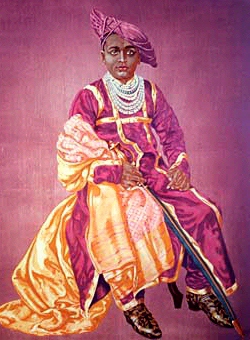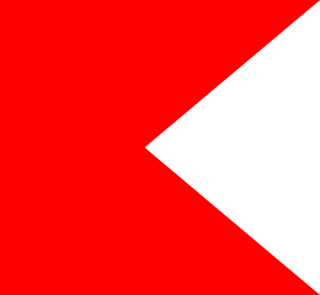
Chhatrapati is a royal title from Sanskrit used to denote a monarch or imperial head of state. The word "Chhatrapati" is a Sanskrit language compound word of chhatra and pati (master/lord/ruler). This title was used by the House of Bhonsle, between 1674 and 1818, as the heads of state of the Maratha Confederacy.

Jijabai Bhonsle (or Bhonsale, Bhosale, Bhosle) or Jadhav, referred to as Rajmata, Rastramata, Jijabai, Jijamata or Jijau, was the mother of Chattrapati Shivaji, founder of the Maratha Empire. She was a daughter of Lakhujirao Jadhav of Sindkhed Raja.

Shahu I was the fifth Chhatrapati of the Maratha Empire founded by his grandfather, Shivaji I. He was born into the Bhonsle family, and was the son of Sambhaji I and Yesubai. At a young age, he was taken into custody at the Siege of Raigad by Mughal emperor Aurangzeb, and held captive by the Mughals. He was released from captivity after the death of Aurangzeb in the hope of engineering an internecine struggle among the Maratha factions of Tarabai and Shahu. Raja Shahu emerged victorious in the bloody Battle of Khed and was crowned as Chhatrapati.

Shahu of the Bhonsle dynasty of Marathas was a Raja and the first Maharaja (1900–1922) of the Indian princely state of Kolhapur. Rajarshi Shahu was considered a true democrat and social reformer. Shahu Maharaj was an able ruler who was associated with many progressive policies during his rule. From his coronation in 1894 till his demise in 1922, he worked for the cause of the lower caste subjects in his state. Primary education to all regardless of caste and creed was one of his most significant priorities.

Satara district is a district of Maharashtra state in western India with an area of 10,480 km2 (4,050 sq mi) and a population of 3,003,741 of which 14.17% were urban. Satara is the capital of the district and other major towns include Medha, Wai, Karad, Malkapur, Koregaon, Rahimatpur, Dahiwadi, Koynanagar, Phaltan, Lonand, Mahabaleshwar, Panchgani, Vaduj and Mhaswad. This district comes under Pune Administrative Division along with Pune, Sangli, Solapur and Kolhapur. The district of Pune bounds it to the north, Raigad bounds it to the north-west, Solapur the east, Sangli to the south, and Ratnagiri to the west.

Saibai Bhosale was the first wife and chief consort of Chattrapati Shivaji, the founder of the Maratha Empire. She was the mother of her husband's successor Chattrapati Sambhaji.

Vyankojirajah Bhonsle or Ekojirajah I Bhonsle was the younger half-brother of Chhatrapati Shivaji Maharaj and founder of Maratha rule in Thanjavur in modern day Tamil Nadu. He was the progenitor of the junior branch of the Bhonsle family which ruled Thanjavur until the formal annexation of the kingdom by the British East India Company in 1855.
Shahu II of the Bhonsle dynasty of the Marathas. He became the ceremonial Chhatrapati Maharaja of Kolhapur in 1983. He is the 12th direct descendant of Emperor Shivaji.

The Lal Mahal of Pune is one of the most famous monuments located in Pune, India, where Shivaji I, founder of the Maratha Empire spent his childhood.
The Shirke is a Maratha clan, found largely in Maharashtra and bordering states of India.

Kolhapur State or Kolhapur Kingdom (1710–1949) was a Maratha princely State of India, under the Deccan Division of the Bombay Presidency, and later the Deccan States Agency. It was considered the most important of the Maratha principalities with the others being Baroda State, Gwalior State and Indore State. Its rulers, of the Bhonsle dynasty, were entitled to a 19-gun salute – thus Kolhapur was also known as a 19-gun state. The state flag was a swallow-tailed saffron pennant.

Akkalkot State during the British Raj, was a Maratha princely state ruled by the Bhonsle dynasty. The non-salute state came under the Deccan States Agency and was bordered by Hyderabad State and the Bombay Presidency.

Bhor State was one of the 9-gun salute Maratha princely states of Deccan States Agency. It was the only state belonging to the Poona Agency under the Bombay Presidency, which became later part of the Deccan States Agency. Along with Akkalkot State, Aundh State, Phaltan State and Jath State, it was one of the Satara Jagirs. The state merged with the newly independent Indian union in 1948.

Pratap Singh Bhonsale was the eighth and last Chhatrapati of the Maratha Empire from 1808 to 1818, when he surrendered to the British during the Third Anglo-Maratha War. He was also the Raja of Satara from 1818 until 1839, when he was replaced with Shahaji of Satara by the British.

Shahu Bhonsle II was the 7th Chhatrapati of the Maratha Confederacy. A member of the Bhonsle clan, he was succeeded by his son Pratap Singh, Raja of Satara Shahu was nominal ruler in Maratha Confederacy. During his reign, the Marathas won the First Anglo-Maratha War, but lost the Second Anglo-Maratha War. Mahadaji Shinde and the Peshwa were his closest counterparts. He died on 3 May 1808.

Rajaram III of the Bhonsle dynasty, was Maharaja of Kolhapur from 1922–1940, succeeding his father Maharaja Shahu. A benevolent ruler, he was instrumental in the uplifting of the dalits and depressed castes in his state. He also established the Kolhapur High Court, modern housing developments, an updated water-supply system, free primary education and higher-level female education.

Shivaji VII was a Maharaja of Kolhapur from the Bhonsle dynasty, reigning from 1941 to 1946. He was from the Satara branch of the Bhonsle dynasty, and had been appointed to the vacant Kolhapur throne from birth, as Rajaram III had only left a daughter. Being so very young, he took no position in ruling the state, which was administered under a regency during his lifetime. He died at the age of 4 in 1946, and was succeeded by Shahaji II.

Satara State was a Maratha rump state later Princely state in India created after the fall of the Maratha Confederacy in 1818 after the Third Anglo-Maratha War and annexed by the British in 1849 using the Doctrine of lapse. The state was ruled by the Bhonsle dynasty, descendants of Shivaji, the founder of the Maratha Empire. The first Raja of the state was Pratap Singh who was installed on the throne by the British after they defeated Peshwa Bajirao II in 1818. Pratap Singh was deposed in 1838. His brother, Shahaji succeeded him but died without a natural heir in 1848. At that time, the East India Company government refused to accept Shahaji's adopted son as his successor under the company's Doctrine of lapse, a policy introduced by the then Governor, Lord Dalhousie, and absorbed the territory into the growing British dominion. Many prominent, influential and politically important families such as the Satara Chitnis Family currently own multiple Wadas in Satara as well.

The Bhonsles of Nagpur were a Maratha royal house that ruled the Kingdom of Nagpur from 1739-1853. They hailed from the Bhonsle clan of Marathas and were one of the most important and powerful Maratha chiefs in the Maratha Empire.

















